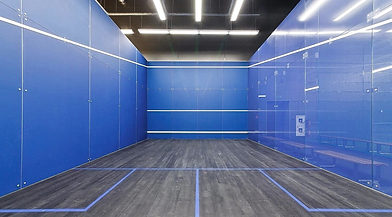
Solid Courts - Huge Differences in Playing Characteristics and Performance
Solid Courts in squash, characterized by three solid walls and a glass back wall, have evolved significantly over the years. Initially constructed with plastered white surfaces until the 1990s, a pivotal shift in design emerged with the introduction of prefabricated wall panels tailored for squash courts in the mid-1990s. Today, the courts utilize four main types of walls: sand-filled, panel, plaster, and solid glass. Each offers unique technical specifics that affect playing characteristics and performance distinctly.
Particularly, the type of wall has substantial impacts on ball rebound behavior and noise levels, crucial factors that should be carefully considered when selecting court types. These characteristics often directly influence court utilization rates, highlighting the importance of tailored court design in enhancing player experience and facility performance.

Sand Filled Walls
Sand-filled wall elements typically consist of prefabricated components made from 18 - 21 mm thick high-density particle boards, which are mounted onto a steel structure. The cavity between these boards is filled with silicate sand, ensuring consistent ball rebound characteristics.The advantages of sand-filled walls include uniform ball rebound, reduced noise levels compared to other types of court walls, and the fact that these prefabricated wall elements are structurally independent from other building walls. This independence allows for more flexible court placement and potentially easier installation in various facility types.

Panel Walls
Panel courts were originally developed for racquetball courts in the USA. They are made from 28 mm or 38 mm thick multi-layer material that is thermally fused to industrial-grade particleboard. The panels are mounted onto a wooden or metal frame structure.
Similar to glass walls, the noise level in a court with panel walls is higher compared to courts with plaster or system walls.

Plaster Walls
Plaster courts were the standard method of court construction throughout the last century. A major advantage of plaster walls is that they are solid and provide a smooth, even surface, which ensures a consistent and true ball bounce. This makes plaster courts known for offering optimum playing conditions.
However, the quality of plaster squash court walls heavily depends on the quality of the underlying building walls. Plaster companies typically only provide guarantees for the surface layer of the walls, which means the overall structural integrity is not covered, offering limited security in terms of long-term durability.

Solid Glass Walls
In general, solid glass walls in squash courts are made of 12 mm thick safety glass panels, like those used in professional show glass courts. These glass panels consist of tempered glass, designed to withstand high mechanical stresses and ensure safety. An important technical feature is the deformation of the glass under dynamic loads. When a squash ball hits the glass at a speed of 200 km/h, the calculated maximum deflection of the 12 mm thick safety glass panel is around 15.7 mm in the center. This demonstrates the elasticity and flexibility of the material, which gives way under impacts, such as a squash ball strike, without breaking.However, this deflection can pose a challenge, particularly for beginner players. Due to the greater flexibility of the glass walls compared to traditional brick walls, the playing experience is altered, making ball returns less predictable and more difficult. Players need to adjust to the slight vibrations and the changed ball rebound, which can affect the playing comfort for less experienced players.